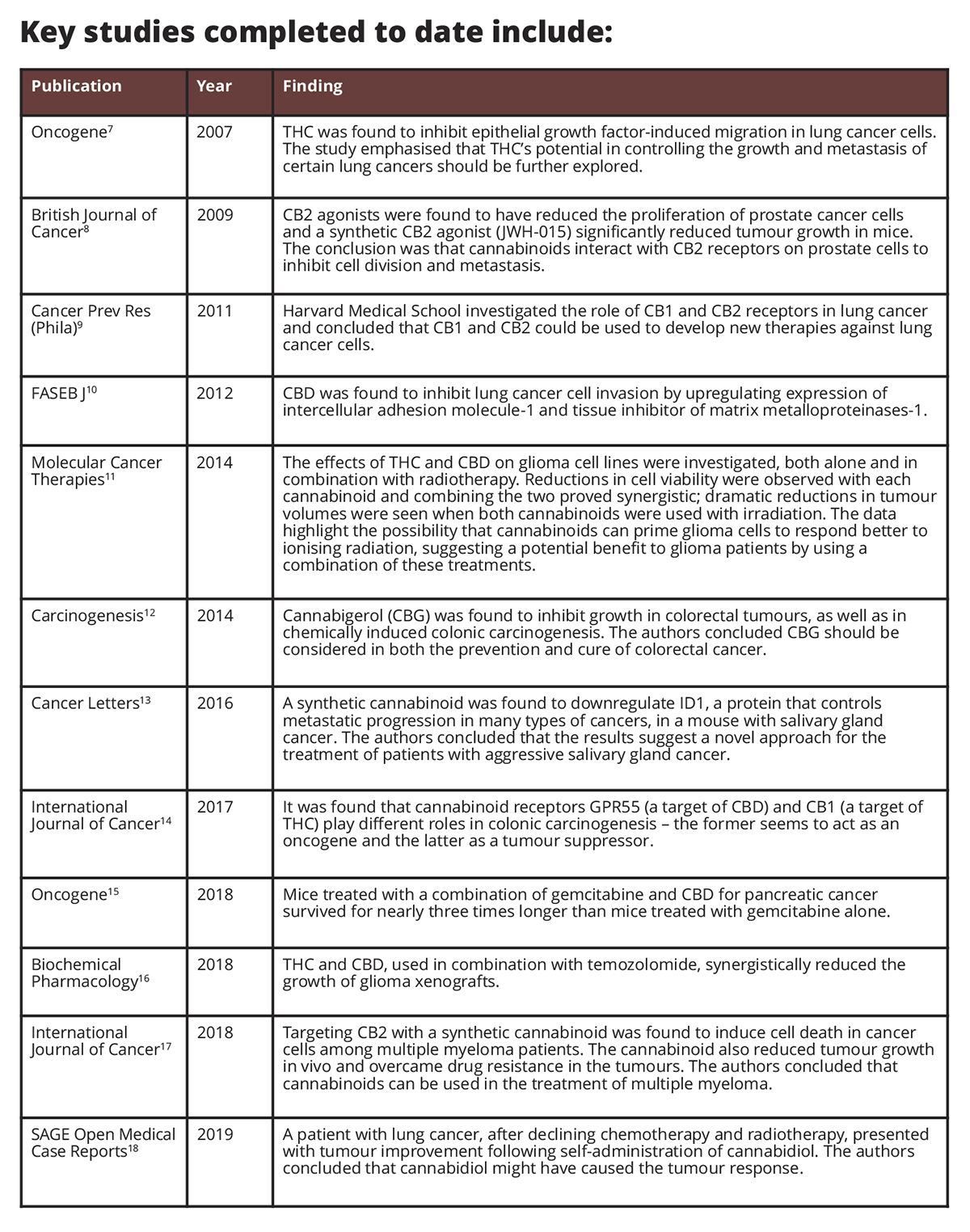In the first of a series of five articles, Oxford Cannabinoid Technologies will discuss their expertise on the medicinal use of cannabis derivatives
This first piece will focus on the use of cannabinoids to treat cancer. The term ‘cannabinoid’ originally referred to a group of compounds found in the species of the cannabis plant known as Cannabis sativa.(1) Following the development of synthetic derivatives of cannabinoids and the discovery of natural endocannabinoids, the term ‘phytocannabinoid’ was given to cannabinoids obtained from cannabis plants.(2)
The best-known of these phytocannabinoids are tetrahydrocannabinol (THC) and cannabidiol (CBD) and two well-known cannabinoid receptors in the brain are CB1 and CB2. The CB1 receptor binds with THC and is thereby responsible for THC’s psychotropic effects. Most if not all phytocannabinoids, however, act on more receptors than just these – the study of these compounds is, therefore, highly complex and their potential to treat a wide range of diseases is highly significant.
Cannabinoids and cancer
The potential of cannabinoids to alleviate the symptoms of cancer and even treat its underlying causes has been discussed since pre-clinical research papers in the early 1970s demonstrated that the growth of lung tumours in mice could be slowed by THC and other cannabinoids.(3) While the ability of cannabinoids to alleviate the symptoms of cancer is widely accepted, pre-clinical studies suggest that cannabinoids may be effective in the actual treatment of multiple cancer types (for instance glioblastoma multiforme((4)) and prostate cancer((5)). Some studies have also affirmed that cannabinoids have a protective effect against certain types of tumours. Others suggest that cannabinoids can inhibit proliferation, metastasis and migration of cancer cells and even induce their death.
Despite these potential anticancer effects of cannabis, it is also important to note that, depending on the drug concentration, studies have found that cannabinoids can both inhibit and stimulate cancer cell proliferation;(6) more research must, therefore, be undertaken on the effects of cannabinoids on different tumour cell types.

Anecdotal evidence
Beyond scientific studies, there have been several ‘real-world’ examples of cannabis having the potential to treat cancer:
- In June 2018, the Coventry Telegraph and Birmingham Mail reported on Joy Smith, a cancer survivor, who was given six weeks to live when she was diagnosed with cancer in her stomach and bowel. Now, two years later, she is close to receiving the all-clear after taking regular doses of THC cannabis oil;(19)
- In June 2018, the Express reported on Garry Hill, 83, who claims CBD oil helped to shrink his tumour by half. His doctor was “amazed” his cancer had shrunk, said Hill, who is now in remission;(20)
- In April 2018, the Birmingham Mail reported on Lynn Cameron, who was given between six and eighteen months to live in 2013 after she was diagnosed with stage 4 brain cancer. When the doctors gave up, Lynn turned to CBD oil. Soon afterwards, her tumour started shrinking. By the sixth MRI, the cancer had gone;(21)
- And in February 2018, the Daily Mail reported on Dee Mani, 44, who refused chemotherapy when she was diagnosed with triple negative breast cancer – deemed the most lethal form – and opted instead to try cannabis oil. Doctors gave her the all-clear just five months after she did so.(22)
Given the growing body of pre-clinical research and anecdotal evidence, the potential curative properties of cannabinoids warrant significant further study. Cancer remains a key focus area for Oxford Cannabinoid Technologies, with multiple programmes already underway aimed at discovering new treatments for a range of cancer types. We look forward to sharing the learnings from these studies in due course.
References
1.) Mechoulam, R., (1967) Recent advances in the chemistry of hashish. Fortschr Chem Org Naturst 25:175–213.
2.) Pate, D. (1999) Anandamide structure-activity relationships and mechanisms of action on intraocular pressure in the normotensive rabbit model. PhD thesis, University of Kuopio, Kuopio, Finland.
3.) Munson, A., et al. (1975) Antineoplastic activity of cannabinoids. Journal of the National Cancer Institute.
4.) Velasco, G., et al. (2004) Hypothesis: Cannabinoid therapy for the treatment of gliomas? Neuropharmacology.
5.) Sarfaraz, S., (2005) Cannabinoid receptor as a novel target for the treatment of prostate cancer. Cancer Research.
6.) Bifulco, M., et al. (2006) Cannabinoids and cancer: pros and cons of an antitumor strategy. British Journal of Pharmacology.
7.) Preet, A. (2007) Δ9-Tet+rahydrocannabinol inhibits epithelial growth factor-induced lung cancer cell migration in-vitro as well as its growth and metastasis in-vivo. Oncogene 27:339. http://www.nature.com/onc/journal/v27/n3/abs/1210641a.html
8.) Olea-Herrero, N., et al. (2009) Inhibition of human tumour prostate PC-3 cell growth by cannabinoids R (+)-Methanandamide and JWH-015: Involvement of CB2. British Journal of Cancer 101:940–950. https://www.nature.com/articles/6605248
9.) Preet, A., et al. (2011) Cannabinoid receptors, CB1 and CB2, as novel targets for inhibition of non-small cell lung cancer growth and metastasis. Cancer Prev Res (Phila) 4(1):65-75. http://www.ncbi.nlm.nih.gov/pubmed/21097714?dopt=Abstract
10.) Ramer, R., et al. (2012) Cannabidiol inhibits lung cancer cell invasion and metastasis via intercellular adhesion molecule-1. 26(4):1535-48. http://www.ncbi.nlm.nih.gov/pubmed/22198381?dopt=Abstract
11.) Scott, KA., et al. (2014) The Combination of Cannabidiol and Δ9-Tetrahydrocannabinol Enhances the Anticancer Effects of Radiation in an Orthotopic Murine Glioma Model. Mol Cancer Ther 10:1158/1535-7163. http://mct.aacrjournals.org/content/early/2014/11/12/1535-7163.MCT-14-0402
12.) Borrelli, F., et al. (2014) Colon carcinogenesis is inhibited by the TRPM8 antagonist cannabigerol, a Cannabis-derived non-psychotropic cannabinoid. Carcinogenesis 35(12):2787-97.
13.) Murase, R., et al. (2016) Suppression of invasion and metastasis in aggressive salivary cancer cells through targeted inhibition of ID1 gene expression. Cancer Lett 377(1):11–16.
14.) Hasenoehrl, C., et al. (2017) G protein-coupled receptor GPR55 promotes colorectal cancer and has opposing effects to cannabinoid receptor 1. Int J Cancer 1:121-132.
15.) Ferro, R., et al. (2018) GPR55 signalling promotes proliferation of pancreatic cancer cells and tumour growth in mice, and its inhibition increases effects of gemcitabine. Oncogene 37(49):6368-6382.
16.) López-Valero, I., et al. (2018) Targeting Glioma Initiating Cells with A combined therapy of cannabinoids and temozolomide. Biochem Pharmacol 157:266-274.
17.) Barbado, MV., et al. (2017) Cannabinoid derivatives exert a potent anti-myeloma activity both in vitro and in vivo. Int J Cancer 3:674-685.
18.) Sulé-Suso, J., et al. (2019) Striking lung cancer response to self-administration of cannabidiol: A case report and literature review. SAGE Open Medical Case Reports 7:1-4.
19.) https://www.coventrytelegraph.net/news/coventry-news/cannabis-oil-cancer-claim-14390091;
https://www.birminghammail.co.uk/news/health/cancer-patient-says-cannabis-oil-14771799
20.) https://www.express.co.uk/life-style/health/970361/cancer-symptoms-lung-tumour-cbd-oil-cannabidiol
21.) https://www.birminghammail.co.uk/news/uk-news/cancer-survivor-praises-cannabis-oil-14341684
22.) https://www.dailymail.co.uk/health/article-5339261/Mother-44-cures-cancer-taking-cannabis-oil.html
John Lucas
Chief Commercial Officer
Oxford Cannabinoid Technologies
Tel: +44 (0)1865 304 040
press@oxcantech.com
www.oxcantech.com
www.twitter.com/OxCanTech
*Please note: This is a commercial profile











